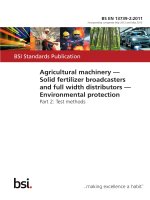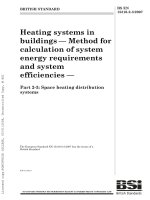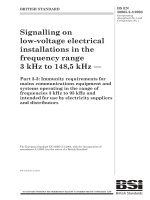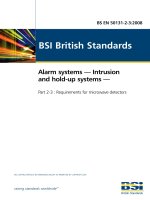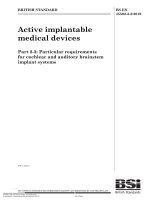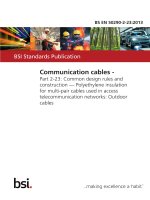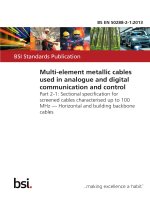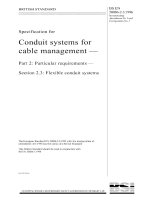Bsi bs en 61326 2 3 2013
Bạn đang xem bản rút gọn của tài liệu. Xem và tải ngay bản đầy đủ của tài liệu tại đây (1.16 MB, 28 trang )
BS EN 61326-2-3:2013
BSI Standards Publication
Electrical equipment for
measurement, control
and laboratory use —
EMC requirements
Part 2-3: Particular requirements —
Test configuration, operational conditions
and performance criteria for transducers with
integrated or remote signal conditioning
(IEC 61326-2-3:2012)
BRITISH STANDARD
BS EN 61326-2-3:2013
National foreword
This British Standard is the UK implementation of EN 61326-2-3:2013.
It is identical to IEC 61326-2-3:2012. It supersedes BS EN 61326-2-3:2006,
which will be withdrawn on 14 August 2015.
The UK participation in its preparation was entrusted by Technical Committee
GEL/65, Measurement and control, to Subcommittee GEL/65/1,
System considerations.
A list of organizations represented on this committee can be obtained on
request to its secretary.
This publication does not purport to include all the necessary provisions
of a contract. Users are responsible for its correct application.
© The British Standards Institution 2013.
Published by BSI Standards Limited 2013.
ISBN 978 0 580 70407 9
ICS 25.040.40; 33.100.01
Compliance with a British Standard cannot confer immunity
from legal obligations.
This British Standard was published under the authority of the
Standards Policy and Strategy Committee on 28 February 2013.
Amendments issued since publication
Amd. No.
Date
Text affected
BS EN 61326-2-3:2013
EN 61326-2-3
EUROPEAN STANDARD
NORME EUROPÉENNE
EUROPÄISCHE NORM
January 2013
ICS 17.220; 19.080; 25.040.40; 33.100
Supersedes EN 61326-2-3:2006
English version
Electrical equipment for measurement, control and laboratory use EMC requirements Part 2-3: Particular requirements Test configuration, operational conditions and performance criteria for
transducers with integrated or remote signal conditioning
(IEC 61326-2-3:2012)
Matériel électrique de mesure, de
commande et de laboratoire Exigences relatives à la CEM Partie 2-3: Exigences particulières Configurations d'essai, conditions de
fonctionnement et critères de performance
des transducteurs avec un système de
conditionnement du signal intégré ou à
distance
(CEI 61326-2-3:2012)
Elektrische Mess-, Steuer-, Regel- und
Laborgeräte EMV-Anforderungen Teil 2-3: Besondere Anforderungen Prüfanordnung, Betriebsbedingungen und
Leistungsmerkmale für
Messgrưßenumformer mit integrierter oder
abgesetzter Signalaufbereitung
(IEC 61326-2-3:2012)
This European Standard was approved by CENELEC on 2012-08-14. CENELEC members are bound to comply
with the CEN/CENELEC Internal Regulations which stipulate the conditions for giving this European Standard
the status of a national standard without any alteration.
Up-to-date lists and bibliographical references concerning such national standards may be obtained on
application to the CEN-CENELEC Management Centre or to any CENELEC member.
This European Standard exists in three official versions (English, French, German). A version in any other
language made by translation under the responsibility of a CENELEC member into its own language and notified
to the CEN-CENELEC Management Centre has the same status as the official versions.
CENELEC members are the national electrotechnical committees of Austria, Belgium, Bulgaria, Croatia, Cyprus,
the Czech Republic, Denmark, Estonia, Finland, Former Yugoslav Republic of Macedonia, France, Germany,
Greece, Hungary, Iceland, Ireland, Italy, Latvia, Lithuania, Luxembourg, Malta, the Netherlands, Norway, Poland,
Portugal, Romania, Slovakia, Slovenia, Spain, Sweden, Switzerland, Turkey and the United Kingdom.
CENELEC
European Committee for Electrotechnical Standardization
Comité Européen de Normalisation Electrotechnique
Europäisches Komitee für Elektrotechnische Normung
Management Centre: Avenue Marnix 17, B - 1000 Brussels
© 2013 CENELEC -
All rights of exploitation in any form and by any means reserved worldwide for CENELEC members.
Ref. No. EN 61326-2-3:2013 E
BS EN 61326-2-3:2013
EN 61326-2-3:2013
-2-
Foreword
The text of document 65A/629/FDIS, future edition 2 of IEC 61326-2-3, prepared by SC 65A, "System
aspects", of IEC TC 65, "Industrial-process measurement, control and automation" was submitted to the
IEC-CENELEC parallel vote and approved by CENELEC as EN 61326-2-3:2013.
The following dates are fixed:
•
•
latest date by which the document has
to be implemented at national level by
publication of an identical national
standard or by endorsement
latest date by which the national
standards conflicting with the
document have to be withdrawn
(dop)
2013-07-10
(dow)
2015-08-14
This document supersedes EN 61326-2-3:2006.
EN 61326-2-3:2013 includes the following significant technical changes with respect to EN 61326-23:2006:
– update of the document with respect to EN 61326-1:2013.
EN 61326-2-3:2013 is to be used in conjunction with EN 61326-1:2013 and follows the same numbering
of clauses, subclauses, tables and figures.
When a particular subclause of EN 61326-1 is not mentioned in this part, that subclause applies as far as
is reasonable. When this standard states “addition”, “modification” or “replacement”, the relevant text in
EN 61326-1 is to be adapted accordingly.
NOTE The following numbering system is used:
– subclauses, tables and figures that are numbered starting from 101 are additional to those in EN 61326-1;
– unless notes are in a new subclause or involve notes in EN 61326-1, they are numbered starting from 101 including
those in a replaced clause or subclause;
– additional annexes are lettered AA, BB, etc.
Attention is drawn to the possibility that some of the elements of this document may be the subject of
patent rights. CENELEC [and/or CEN] shall not be held responsible for identifying any or all such patent
rights.
This document has been prepared under a mandate given to CENELEC by the European Commission
and the European Free Trade Association, and supports essential requirements of EU Directive(s).
For the relationship with EU Directive(s) see informative Annex ZZ, which is an integral part of this
document.
Endorsement notice
The text of the International Standard IEC 61326-2-3:2012 was approved by CENELEC as a European
Standard without any modification.
-3-
BS EN 61326-2-3:2013
EN 61326-2-3:2013
Annex ZA
(normative)
Normative references to international publications
with their corresponding European publications
The following documents, in whole or in part, are normatively referenced in this document and are
indispensable for its application. For dated references, only the edition cited applies. For undated
references, the latest edition of the referenced document (including any amendments) applies.
NOTE When an international publication has been modified by common modifications, indicated by (mod), the relevant EN/HD
applies.
Annex ZA of EN 61326-1:2013 applies, except as follows:
Publication
Year
Title
EN/HD
Year
2012
Electrical equipment for measurement,
control and laboratory use EMC requirements Part 1: General requirements
EN 61326-1
2013
Addition:
IEC 61326-1
BS EN 61326-2-3:2013
EN 61326-2-3:2013
-4-
Annex ZZ
(informative)
Coverage of Essential Requirements of EU Directives
This European Standard has been prepared under a mandate given to CENELEC by the European
Commission and the European Free Trade Association and within its scope the standard covers
protection requirements of Annex I, Article 1 of the EC Directive 2004/108/EC.
Compliance with this standard provides one means of conformity with the specified essential
requirements of the Directive[s] concerned.
NOTE
Other requirements and other EU Directives may be applicable to the products falling within the scope of
this standard.
–2–
BS EN 61326-2-3:2013
61326-2-3 © IEC:2012
CONTENTS
1
Scope ............................................................................................................................... 6
2
Normative references ....................................................................................................... 8
3
Terms and definitions ....................................................................................................... 8
4
General ............................................................................................................................ 9
5
EMC test plan ................................................................................................................... 9
6
5.1 General ................................................................................................................... 9
5.2 Configuration of EUT during testing ......................................................................... 9
5.3 Operation conditions of EUT during testing .............................................................. 9
5.4 Specification of functional performance ................................................................. 10
5.5 Test description ..................................................................................................... 10
Immunity requirements ................................................................................................... 10
7
6.1 Conditions during the tests .................................................................................... 10
6.2 Immunity test requirements ................................................................................... 10
6.3 Random aspects.................................................................................................... 11
6.4 Performance criteria .............................................................................................. 11
Emission requirements ................................................................................................... 12
8
7.1 Conditions during measurements .......................................................................... 12
7.2 Emission limits ...................................................................................................... 12
Test results and test report ............................................................................................. 12
9
Instructions for use ......................................................................................................... 12
Annex A (normative) Immunity test requirements for portable test and measurement
equipment powered by battery or from the circuit being measured ........................................ 13
Annex AA (normative) Additional requirements and exceptions for specific types of
transducers – Transducers for measurement of tension and compressive forces (force
transducers) ......................................................................................................................... 14
Annex BB (normative) Additional requirements and exceptions for specific types of
transducers – Transducers for measurement of pressure (pressure transducers) .................. 17
Annex CC (normative) Additional requirements and exceptions for specific types of
transducers – Transducers for measurement of temperature (temperature transducer) ......... 19
Bibliography .......................................................................................................................... 22
Figure 101 – Example of a transducer with integrated signal conditioning ............................... 7
Figure 102 – Example of a transducer with remote signal conditioning .................................... 7
Figure AA.1 – Example of the configuration of a force transducer with remote signal
conditioning .......................................................................................................................... 15
Figure BB.1 – Example of the configuration of a pressure transducer ................................... 18
Figure CC.1 – Example of the configuration of a temperature transducer with sensor
and signal conditioning in the same housing ......................................................................... 20
Figure CC.2 – Example of the configuration of a temperature transducer with remote
signal conditioning ................................................................................................................ 20
BS EN 61326-2-3:2013
61326-2-3 © IEC:2012
–3–
Table 101 – Performance criteria for the different functions .................................................. 11
Table AA.1 – Circuitry actions for generating an output signal for simulation of a
mechanical load on the transducer ........................................................................................ 15
–6–
BS EN 61326-2-3:2013
61326-2-3 © IEC:2012
ELECTRICAL EQUIPMENT FOR MEASUREMENT,
CONTROL AND LABORATORY USE –
EMC REQUIREMENTS –
Part 2-3: Particular requirements –
Test configuration, operational conditions and performance
criteria for transducers with integrated or remote signal conditioning
1
Scope
In addition to the requirements of IEC 61326-1, this part specifies more detailed test
configurations, operational conditions and performance criteria for transducers with integrated
or remote signal conditioning.
This standard applies only to transducers characterized by their ability to transform, with the
aid of an auxiliary energy source, a non-electric quantity to a process-relevant electrical
signal, and to output the signal at one or more ports. This standard includes transducers for
electrochemical and biological measured quantities.
The transducers covered by this standard may be powered by a.c. or d.c. voltage and/or by
battery or with internal power supply.
Transducers referred to by this standard comprise at least the following items (see
Figures 101 and 102):
–
one or more elements for transforming a non-electrical input quantity to an electrical
quantity;
–
a transmission link for transferral of the electrical quantity to a component for signal
conditioning;
–
a unit for signal conditioning that converts the electrical quantity to a process-relevant
electrical signal;
–
an enclosure for enclosing the above-stated components fully or in parts.
Transducers referred to by this standard may also have the following items (see Figures 101
and 102):
–
a communication and control unit;
–
a display unit;
–
control elements such as keys, buttons, switches, etc.;
–
transducer output signals (for example, switch outputs, alarm outputs) which are clearly
assigned to the input signal(s);
–
transducers with signal conditioning which may be integrated or remote.
The manufacturer specifies the environment for which the product is intended to be used and
utilizes the corresponding test levels of IEC 61326-1.
Additional requirements and exceptions for specific types of transducers are given in the
annexes to this standard.
61326-2-3 © IEC:2012
–7–
4
1
8
3
2
9
7
5
6
IEC 559/02
Key
1
Non-electrical quantity
2
Electrical quantity
3
Transmission link
4
Signal conditioning
5
Communication and control unit
6
Input/output ports
7
Power supply
8
Signal port
9
AC/DC power port
Figure 101 – Example of a transducer with integrated signal conditioning
4
1
8
3
2
9
7
5
6
IEC 560/02
Key
1
Non-electrical quantity
2
Electrical quantity
3
Transmission link
4
Signal conditioning
5
Communication and control unit
6
Input/output ports
7
Power supply
8
Signal port
9
AC/DC power port
Figure 102 – Example of a transducer with remote signal conditioning
–8–
2
BS EN 61326-2-3:2013
61326-2-3 © IEC:2012
Normative references
The following documents, in whole or in part, are normatively referenced in this document and
are indispensable for its application. For dated references, only the edition cited applies. For
undated references, the latest edition of the referenced document (including any
amendments) applies.
Clause 2 of IEC 61326-1:2012 applies, except as follows:
Addition:
IEC 61326-1:2012, Electrical equipment for measurement, control and laboratory use – EMC
requirements – Part 1: General requirements
3
Terms and definitions
For the purposes of this document, the terms and definitions of IEC 61326-1 apply, except as
follows.
Addition:
3.101
transducer with integrated signal conditioning
transducer in which all components for signal conditioning are integrated in the enclosure
(see Figure 101)
3.102
transducer with remote signal conditioning
transducer whose components for signal conditioning are installed in separate enclosures
(see Figure 102)
3.104
transmission link
connection between the individual components of a transducer with remote signal conditioning
3.105
(nominal) range
range of indications obtainable with a particular setting of the controls of a measuring
instrument
Note 1 to entry: The nominal range is normally stated in terms of its lower and upper limits. Where the lower limit is
zero, the nominal range is commonly stated solely in terms of its upper limit.
[SOURCE: IEC 60050-300:2001, 311-03-14]
3.106
measuring range (of a transducer)
range defined by two values of the measured quantity within which the relationship between
the output and input signals complies with the accuracy requirements
[SOURCE: IEC 60050-300:2001, 314-04-04, modified]
Note 1 to entry: For a 4 mA to 20 mA system, the output current 4 mA represents the lower limit for the measured
quantity and 20 mA represent the upper limit.
3.107
span
algebraic difference between the values of the upper and lower limits of the measuring range
BS EN 61326-2-3:2013
61326-2-3 © IEC:2012
–9–
[SOURCE: IEC 60050-300:2001, 311-03-13]
3.108
intrinsic uncertainty
uncertainty of a measuring instrument when used under reference conditions
Note 1 to entry: This term is used in the “uncertainty” approach
[SOURCE: IEC 60050-300:2001, 311-03-09]
4
General
Clause 4 of IEC 61326-1:2012 applies.
5
EMC test plan
5.1
General
Subclause 5.1 of IEC 61326-1:2012 applies.
5.2
Configuration of EUT during testing
Subclause 5.2 of IEC 61326-1:2012 applies, except as follows.
5.2.1
General
Subclause 5.2.1 of IEC 61326-1:2012 applies, except as follows:
Addition:
A system for monitoring the behaviour of the EUT and for registering the output values shall
be designed in such a way that the electromagnetic compatibility characteristics of the EUT
are not impaired. The monitoring system shall also be designed such that its response is not
affected by the immunity tests. The input impedance of the monitoring system shall
correspond to the terminating impedance of the transducer, specified by the manufacturer.
The distance between the monitoring system and the EUT should be at least 1,5 m.
The measurement uncertainty and the bandwidth of the monitoring system shall be adapted to
the characteristics of the transducer.
Transmission links are considered as separate input and output lines.
The tests shall be conducted in compliance with the environmental conditions for the
transducer specified by the manufacturer and using the specified supply voltage.
In the case of battery-operated transducers that can also be used when connected with a
power supply, both operating modes (stand-alone and externally supplied) shall be tested.
In cases in which the manufacturer's installation instructions stipulate the use of external
protective equipment or particular protective measures that are explicitly stated in the
operating manual, the test requirements given in this part of the standard shall be applied for
use together with the external protective equipment or measures.
5.3
Operation conditions of EUT during testing
Subclause 5.3 of IEC 61326-1:2012 applies.
– 10 –
5.4
BS EN 61326-2-3:2013
61326-2-3 © IEC:2012
Specification of functional performance
Subclause 5.4 of IEC 61326-1:2012 applies.
5.5
Test description
Subclause 5.5 of IEC 61326-1:2012 applies.
6
6.1
Immunity requirements
Conditions during the tests
Subclause 6.1 of IEC 61326-1:2012 applies except as follows:
Addition:
Transducers shall be operated during the test with all lines connected, provided the ports do
not have functions that contravene the definition of a transducer's function.
Configurations with alternative ports shall be tested separately.
Transducers shall be set to the most sensitive ranges or combination of ranges unless other
ranges are known to provide worst-case immunity results within normal application.
Only operational functions compliant with the specified use under the nominal conditions are
permitted. Defined functions that cannot be set under electromagnetic compatibility test
conditions shall be simulated by appropriate measures. This shall be done in such a way that
the electromagnetic compatibility behaviour of the transducer is not affected.
Measurement and supply circuits shall be grounded in accordance with the manufacturer's
specifications. If no such specifications are given, the tests shall be carried out with the
circuits grounded and with the circuits ungrounded.
6.2
Immunity test requirements
Subclause 6.2 of IEC 61326-1:2012 applies except as follows:
Addition:
After or during each test, the function of the transducer shall be tested.
Power inputs for voltages up to 75 V d.c. or voltages up to 50 V a.c. that are fed in a single
cable together with the input and output ports are tested as input and output ports.
Power inputs for voltages up to 75 V d.c. or voltages up to 50 V a.c. with superimposed output
signals (for example, 4 mA to 20 mA current loop with two-wire technology) are also tested as
input/output ports.
The transmission link of a transducer with remote signal conditioning is tested as an
input/output port.
If there are any manufacturer's specifications present to the insulation resistance then these
shall be checked once again after ESD, fast transient (burst) and surge tests. If the
manufacturer's specifications are not satisfied, the transducer is deemed to have failed the
EMC tests.
BS EN 61326-2-3:2013
61326-2-3 © IEC:2012
6.3
– 11 –
Random aspects
Subclause 6.3 of IEC 61326-1:2012 applies.
6.4
Performance criteria
Subclause 6.4 of IEC 61326-1:2012 applies except as follows:
Addition:
The performance criteria are used to assess the defined functions of a transducer under the
effects of external electromagnetic disturbances. Since a transducer is often part of a chain of
functions in a large process, effects on the overall process due to malfunctions of a
transducer caused by external interference factors cannot be predicted without great difficulty.
For this reason, it is particularly important that the behaviour of transducers under the
influence of electromagnetic disturbances is described with performance criteria by the
manufacturer.
Table 101 describes the permissible effects of a disturbance on the different functions of a
transducer with regard to the required performance criteria.
Table 101 – Performance criteria for the different functions
Function
Main function
a
Additional particular performance criteria
for performance criterion A
for performance criterion B
for performance criterion C
The deviations during the
test are within the limit
values for intrinsic
uncertainty specified and
documented by the
manufacturer
The deviations during the
test are within the limit
values for additional
deviations specified and
documented by the
manufacturer
The deviations during the
test may be outside the
limit values specified and
documented by the
manufacturer. After the
test, the measured values
are within the specified
range.
The manufacturer shall
specify the time that is
required to regain normal
function after the end of the
test.
Process communication
Communication as
intended
Temporary interference of
the communication is
permitted during the test.
Interference of the
communication is permitted
during the test.
The manufacturer shall
specify the time that is
required to regain normal
function after the end of the
test.
Alarm function
a
No malfunctions permitted
Temporary interference of
the communication is
permitted during the test.
Malfunctions are permitted.
The manufacturer shall
specify the time that is
required to regain normal
function after the end of the
test.
The main function of a measuring transducer is to transform a non-electrical quantity into a process-relevant
signal as shown in Figures 101 and 102.
– 12 –
7
7.1
Emission requirements
Conditions during measurements
Subclause 7.1 of IEC 61326-1:2012 applies except as follows:
Addition:
The additions made in Clauses 5 and 6 shall be taken into account.
7.2
Emission limits
Subclause 7.2 of IEC 61326-1:2012 applies.
8
Test results and test report
Clause 8 of IEC 61326-1:2012 applies.
9
Instructions for use
Clause 9 of IEC 61326-1:2012 applies.
BS EN 61326-2-3:2013
61326-2-3 © IEC:2012
BS EN 61326-2-3:2013
61326-2-3 © IEC:2012
– 13 –
Annex A
(normative)
Immunity test requirements for portable test and measurement
equipment powered by battery or from the circuit being measured
Annex A of IEC 61326-1:2012 does not apply.
Additional annexes:
– 14 –
BS EN 61326-2-3:2013
61326-2-3 © IEC:2012
Annex AA
(normative)
Additional requirements and exceptions
for specific types of transducers –
Transducers for measurement of tension
and compressive forces (force transducers)
AA.1 General considerations
In addition to the requirements of the main part of this standard, this Annex AA describes
particular EMC requirements for force transducers that permit static measurement quantities.
Force transducers comprise at least the following components:
•
a deflection unit that records mechanical forces as input quantities;
•
one or more converting elements for generating electrical signals proportional to the
mechanical input quantities;
•
a measurement signal amplifier for processing the electrical signals into process-relevant
signals.
AA.2 Test configuration
The force transducer shall be tested in the position specified by the manufacturer (see
Figure AA.1).
If no installation position is specified by the manufacturer, the transducer shall be positioned
in such a way that the force is applied vertically.
The grounding of the power supply and force transducer shall comply with the manufacturer's
specifications. If none are given, the power supply for voltages less than 70 V d.c. shall be
grounded and the transducer shall be tested both grounded and insulated from ground.
Connections to functional earth shall only be made at terminals of the force transducer
intended for that purpose.
If the ports are implemented in the form of plug-in connectors and if they have a terminal for a
cable shield then the shield shall be connected with the functional earth port. Preinstalled
cable connectors with shielding shall be connected accordingly.
The mounting parts for securing the transducer in a fixed position and the mounting plate
shall not be made of conductive material unless specified otherwise by the manufacturer. The
outer distance A between the components should not be greater than 1 m.
BS EN 61326-2-3:2013
61326-2-3 © IEC:2012
– 15 –
6
F
8
5
2
1
9
3
A
4
7
IEC 561/02
Key
1
Deflection unit
2
3
4
Remote signal conditioning
Transmission link
AC/DC mains port
5
Input/output port
6
7
8
9
F
A
Measurement output port
Mounting part
Load button
Mounting plate
Tension/compressive force
Outer distance between deflection unit and remote signal conditioning (max. 1 m)
Figure AA.1 – Example of the configuration of a force transducer
with remote signal conditioning
AA.3 Operation conditions
The EUT shall be operated with the specified rated supply voltage. If the maximum rated
supply voltage differs from the minimum rated supply voltage by more than a factor of 2, the
EMC tests conducted on the power input lines shall be performed at both the minimum and
the maximum rated supply voltages.
Force transducers are tested under static, mechanical load.
If a mechanical load cannot be applied to the force transducer in the test environment, an
output signal may be generated using suitable circuitry connected to the transducer elements.
This circuitry shall be connected directly to the transducer elements in the transducer
housing. The application of each circuitry action shall be described and justified in the test
report.
Example for possible circuitry actions are listed in Table AA.1.
Table AA.1 – Circuitry actions for generating an output signal
for simulation of a mechanical load on the transducer
Transducer technology
Circuitry actions used for simulation
Strain gauge
Detune the measuring bridge with fixed-value resistors
Capacitive elements
Detune the measuring bridge with capacitors and/or fixed-value
resistors in the case of half-bridges
– 16 –
BS EN 61326-2-3:2013
61326-2-3 © IEC:2012
The force shall be between 30 % and 70 % of the nominal force range. In the case of an
expanded measurement range, the main function output signal should also be within 30 %
and 70 % of the output signal operating range. In the case of a ± range, zero values – for
example 0,0 mA or 0,0 V – should not be chosen.
An alarm function shall be configured in such a way that the difference between the actual
measuring value and the adjusted alarm value corresponds to twice of the specified accuracy
allowed for the tested measurement span.
Two situations shall be tested:
a) the adjusted alarm value is above the actual measuring value;
b) the adjusted alarm value is below the actual measuring value.
If the initiation threshold value of the alarm function is within 30 % to 70 % of the rated test
value range, it can be tested together with the other outputs.
BS EN 61326-2-3:2013
61326-2-3 © IEC:2012
– 17 –
Annex BB
(normative)
Additional requirements and exceptions
for specific types of transducers –
Transducers for measurement of pressure
(pressure transducers)
BB.1 General considerations
In addition to the requirements of the main part of this standard, this Annex BB describes
particular EMC requirements for pressure transducers.
Pressure transducers consist of at least the following:
•
a process connection for pressure-sealed connection to the process;
•
a sensor element for conversion of pressure to a quantity that can be electrically processed;
•
a signal conditioning unit for formatting, linearizing, amplifying and converting the
electrical quantity to a process-compliant signal.
This annex does not apply to pressure measurement equipment operating purely on a
mechanical basis – for example, spring-tube manometers with limit switches.
BB.2 Test configuration
All tests shall be carried out in the pressure transducer position specified by the manufacturer
(see Figure BB.1).
If no position is specified, the tests shall be performed in the position considered to be the
least favourable and noted in the test report.
Components for pressure measurement to a test object should affect the test configuration as
little as possible. For this reason, the dimensions of metallic pressure adapters should not be
more than twice the size of the EUT. Pipes to pressure connection, pressure controllers and
the used media should be electrically insulated if conductive pipes or media may influence the
test result.
The tests shall be carried out with all the electrical connection elements specified by the
manufacturer fully assembled and connected.
The grounding of the transducer and the power supply shall be in accordance with the
manufacturers specifications.
If not specified by the manufacturer, the EUT shall be prepared in the following way:
•
if the process connection is made of metal, it shall be grounded. Sealants are not allowed
to impair the resistance to the grounding terminal;
•
if a terminal is provided for functional grounding, it shall be grounded;
•
if terminals have an option for a cable shield connection, the option shall be used for
connecting the shield;
•
the power supply shall be insulated from the ground.
– 18 –
BS EN 61326-2-3:2013
61326-2-3 © IEC:2012
Key
1
Process medium
2
Pipe
3
Pressure adapter
4
Pressure transducer
5
Ground connection
6
Insulated spacer
NOTE
See relevant basic standards for the height of the insulated spacer.
7
Reference ground
8
Connecting n line(s)
Figure BB.1 – Example of the configuration of a pressure transducer
BB.3 Operation conditions
The EUT shall be operated with the specified rated supply voltage. If the maximum rated
supply voltage differs from the minimum rated supply voltage by more than a factor of 2, the
conducted EMC tests on the power input lines shall be performed at both the minimum and
the maximum rated supply voltages.
The pressure shall be between 30 % and 70 % of the nominal pressure range. In the case of
an expanded measurement range, the main function output signal should also be within 30 %
and 70 % of the output signal operating range. In the case of a ± range, zero values – for
example, 0,0 mA or 0,0 V – should not be chosen.
Adjustable pressure transducers shall be set in accordance with the manufacturer’s
specifications. If no manufacturer specifications are given, use the following settings:
•
most sensitive measurement range;
•
minimum time constant/response time;
•
highest data transfer rate.
BS EN 61326-2-3:2013
61326-2-3 © IEC:2012
– 19 –
Annex CC
(normative)
Additional requirements and exceptions
for specific types of transducers –
Transducers for measurement of temperature
(temperature transducer)
CC.1 General considerations
In addition to the requirements of the main part of this standard, this Annex CC describes
particular EMC requirements for temperature transducers.
Temperature transducers comprise at least the following components:
•
one or more temperature sensors (for example, thermocouple, PT-100);
•
a signal conditioning unit for formatting, linearizing, amplifying and converting the
electrical input signal to a process-compliant signal;
•
signal port with attached cable for signal transfer (for example, two-wire 4 mA to 20 mA
link).
The temperature transducer may also have the following components:
•
one or more transmission links between temperature sensor and processing unit;
•
port for separate power supply.
CC.2 Test configuration
The test setup shall be as close as possible to real installations. Deviations from the test setup described in the basic standards cited that might be necessary due to special demands of
temperature transducers shall be described and justified in the test report. The cable types
shall be chosen according to the manufacturers’ installation guides. If no special cables are
prescribed, common unshielded and untwisted cables shall be used in the test setup.
For analogue output signals, a load within the specification of the manufacturer shall be
connected, for which the EUT is expected to be most susceptible to EMC phenomena.
If the temperature transducer is only used and delivered as a single unit (sensor and
processing unit within the same housing), it shall be tested in this configuration (see test
setup in Figure CC.1). In all other cases, the test setup in Figure CC.2 shall be used. The
length of the cables shall be in accordance with the basic standards. The tests shall be
carried out with all electrical connection elements fully assembled and connected as specified
by the manufacturer. The temperature transducer and power supply shall be connected to
ground in accordance with the specifications of the manufacturer.
The room temperature should be used as the reference measurement quantity. Care shall be
taken that the temperature is constant within an appropriate temperature interval to evaluate
the performance of the transducer. If this is not possible (for example, due to the measuring
range of the transducer), the sensor of the transducer shall be mounted on a suitable medium
representing the process temperature or the room temperature shall be taken into account via
a separate temperature measurement. Simulations (networks of resistors and/or other passive
components or batteries) can be used instead of a passive sensor or thermocouple, if
equivalence of the high-frequency characteristics can be proved so as to ensure a similar
electromagnetic behaviour.
– 20 –
BS EN 61326-2-3:2013
61326-2-3 © IEC:2012
IEC 1243/06
Key
1
2
3
4
5
Temperature transducer (orientation of transducer only as an example)
Auxiliary equipment (for example, power supply, signal evaluation, or system for transmission of the signal)
Link cable, unshielded, untwisted, if not specified otherwise
Insulated spacer (dimension according to the relevant basic standard)
Reference ground
Figure CC.1 – Example of the configuration of a temperature transducer
with sensor and signal conditioning in the same housing
IEC 1244/06
Key
1
2
3
4
5
6
7
Temperature sensor
Auxiliary equipment (for example, power supply, signal evaluation)
Link cable, unshielded, untwisted, if not specified otherwise
Insulated spacer (dimension according to the relevant basic standard)
Reference ground
Signal conditioning unit of the transducer
Link cable, unshielded, untwisted, if not specified otherwise
Figure CC.2 – Example of the configuration of a temperature transducer
with remote signal conditioning
BS EN 61326-2-3:2013
61326-2-3 © IEC:2012
– 21 –
CC.3 Operation conditions
The EUT shall be operated with the specified rated supply voltage. If the maximum rated
supply voltage differs from the minimum rated supply voltage by more than a factor of 2, the
EMC tests conducted on the power input lines shall be performed at both the minimum and
the maximum rated supply voltages.
The transducer shall be adjusted so that at the applied temperature, a transducer output
signal of 40 % to 60 % of the output signal range is generated (for example, 12 mA of a 4 mA
to 20 mA system). In the case of a signed output range, zero values – for example, 0,0 mA or
0,0 V – shall not be chosen.
The following settings shall be used, if not otherwise specified by the manufacturer:
•
most sensitive measurement range;
•
minimum time constant/response time;
•
highest data rate.
An alarm function, if available, shall be configured as defined by the manufacturer. If no
definition is given by the manufacturer the alarm function shall be configured in such a way
that the difference between the actual measuring value and the adjusted alarm value
corresponds to the precision of the device.
Two situations shall be tested:
1) the adjusted alarm value is above the actual measuring value;
2) the adjusted alarm value is below the actual measuring value.
If the initiation threshold value of the alarm function is within 40 % to 60 % of the chosen
output signal range, the alarm function can be tested together with the other functions.
– 22 –
BS EN 61326-2-3:2013
61326-2-3 © IEC:2012
Bibliography
IEC 60050
(all
parts),
International
<>)
Electrotechnical
___________
Vocabulary
(available
at
